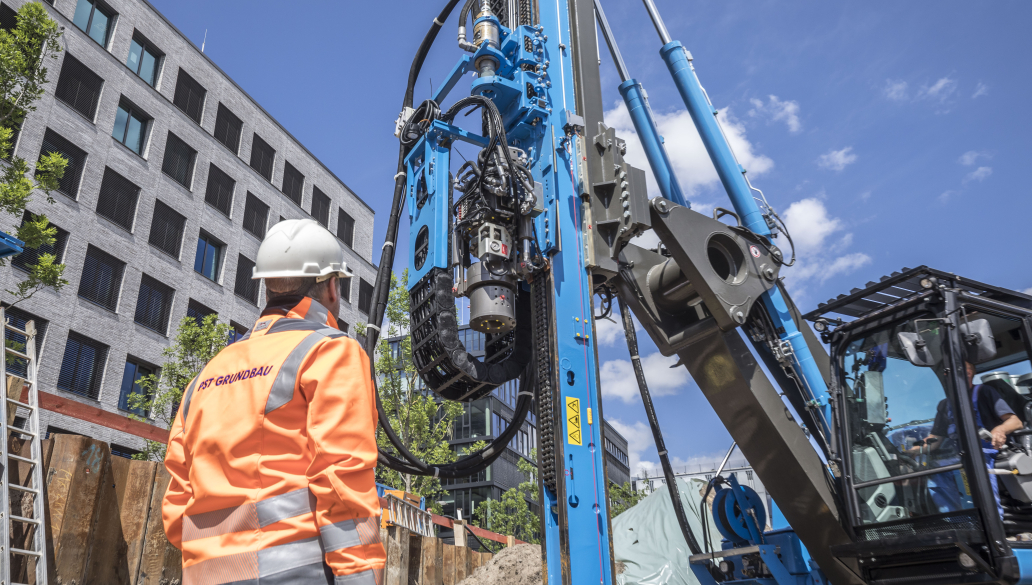Facts
Location
Berlin
Nemetschek Group Brands
NEVARIS
Sector
Special foundation engineering, environmental engineering, dewatering work
Client
PST Grundbau
Technology used
NEVARIS Build, 123onsite, NEVARIS Inform
The introduction of digital processes and the switch to smart technologies in everyday planning requires a management that supports change management in its own company and treads the path together with its employees. Oliver Ostrzinski, together with Ralph Schuster, is the managing director of PST Grundbau and Brechtel Spezialtiefbau from Berlin. Both companies belong to Celler Brunnenbau and have focused their business on special foundation engineering, environmental engineering and dewatering work. Software solutions from NEVARIS have been in use here for more than 20 years and provide support at many points in the workflow. We talked to him about his personal experiences with the digitalization of business processes.
Mr. Ostrzinski, you have known your companies since 1995 and have thus been part of the Celle Brunnenbau Group since 2002. How do you assess the degree of digitization in your company and across the Group? And how well is the cooperation with external project partners working at this point?
PST Grundbau and Brechtel Spezialtiefbau are already in a very good position compared to others, in my opinion. We specifically rely on specific software solutions for our tasks. By integrating NEVARIS Finance into our internal processes, for example, many everyday tasks can be mapped completely digitally. NEVARIS Inform is our central CRM solution for project management and inquiry lists. We also use NEVARIS Build intensively. Added to this is 123erfasst, whose introduction is just around the corner.
The integration of our project partners, on the other hand, is more complex because each of them works with their own tools. We have very little influence on this. Nevertheless, they use their tools optimally - and we are of course not the only or most important partners. In addition, we are often hired directly by clients. For us, this has the advantage that we can offer a complete trade. For the clients, in turn, this results in a high degree of cost certainty, because there is no need to coordinate additional subcontractors. We bear the risk when providing the services.
What impact does digitization have on your working environment today - and as far as you can estimate for the future?
Digitalization means that the demands on construction companies are changing ever faster. For example, our builders expect us to provide relevant project and planning information ever more quickly. This not only affects internal communication processes and the associated depth of information. In addition, we have a lot of equipment in use on construction sites that is literally crammed with technology. From these, we can generate data providing the client with a new quality of information. However, in doing so, we are creating a steadily growing expectation that this data will always and automatically be supplied in the future.
Optimized digital processes increase efficiency in project workflows with all participants and thus create economic benefits. Where are the benefits for your companies?
In any case, I see the big speed gain. If we look at the incoming orders and the calculation, it is immense. Although we never dig a standard excavation pit, we still use standardized calculations stored in the system for this construction task. Until a few years ago, we worked with individual, manual calculations instead, which each estimator created for himself. With our NEVARIS Build calculation software, the processes are now always the same. In the event of a replacement due to illness or vacation, each estimator can quickly familiarize himself with the project. At the same time, however, we still have direct contact between the employee who accepts the order and the one who later handles it. In addition, everything is traceable and comprehensive documentation is possible vis-à-vis the client. Particularly in the case of supplements, it is important to present the documentation of the effort transparently.
What digital tools do you use to optimize process flows, both internally and externally?
In addition to the NEVARIS tools mentioned, we also use MS Office applications. We conduct certain internal planning, especially personnel and equipment planning, manually and in MS Project or Excel. However, this will soon change. In the future, we will use 123erfasst for this - an app solution for digital time recording and automated creation of daily construction reports. Furthermore, I have to say: If we had to replace even more software or even add new ones, it would mean that the ones we currently use cannot map our business processes. But this is by no means the case.
Mr. Ostrzinski, do you have a wish that you would like to address directly to the construction software industry? For example, on topics such as interoperability or the focus on the construction company target group?
Yes, I certainly do: The cross-software exchange of data should function as smoothly as possible. This is not always the case between the various solutions of the providers on the market. At the same time, something has to change in the minds of the contractors. Because a standardized exchange would mean being open to scrutiny. Skepticism about such openness in the project is still very high in Germany.




